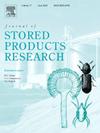Changes in nutritional and hygienic quality due to storage of common native and processed grain cereals intended for horse feeding
Abstract
Horses are sensitive to feed hygiene change. Commercial products are expected to be clean and safe but substandard storage conditions could compromise the nutritional and hygienic quality. We assessed changes in the nutritional and hygienic properties of common cereals (oat, maize and barley) in native (whole) and processed (flaked) forms in response to storage conditions. Commercially bagged cereals for horses were subjected to 3 storage conditions: freshly opened (control), open-bag storage and sealed-bag storage for 42 d kept in a feed storage room of a privately owned horse farm. The temperature and relative humidity of the storage room ranged from 17 to 21 °C and 58–74%, respectively. Two samples were taken from the top and bottom positions of each bag (total n = 36) for analyses. Microscopic evaluations showed that oat samples contained 3–5 times higher numbers of impurities than maize and barley. Maize samples were highest in the number of flawed grains, while barley showed the greatest number of pest components. High counts of impurities, flawed grains and pest components were already found in the control samples, and the storage conditions did not promote more damage and contaminants or alter the chemical composition of samples. Sensory evaluation did not detect differences among samples. Processing enlarged the particle size of all grain sorts and promoted physical damage to maize in particular. Five samples analyzed for mycotoxins and other contaminants revealed the prevalence of secondary metabolites of Fusarium and Alternaria spp. (each group showing 80% frequency and >500 μg/kg). Ergot alkaloids were absent. Fumonisin B1 and B2 were exclusively detected in maize samples (max concentration = 267 and 36 μg/kg, respectively) and pesticide residues in barley samples. Our data indicate specific impurities, damages and contaminants associated with certain grain sort and processing with little impact of the test storage conditions.
| 公司名称 | 产品信息 | 采购帮参考价格 |
|---|

 求助内容:
求助内容: 应助结果提醒方式:
应助结果提醒方式:


